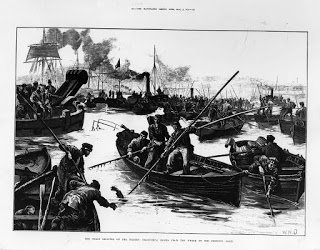The late Peter Haining was one of many writers fascinated by the terrible events of the evening of 3rd September 1878, when the paddle steamer ‘Princess Alice’, laden with over 800 day trippers returning from an excursion to Margate, was rammed by the collier Bywell Castle close to North Woolwich. Over 630 men, women and children perished in the disaster, which remains the worst in the history of river navigation—not just in the UK, but in the world.
Hoping to publish a book on the subject, Peter Haining kept clippings both from the centenary coverage of the disaster in 1978 and from August 1989,when a much smaller vessel, the ‘Marchioness’, sank further upstream in the Thames. He also researched a similar Victorian sinking in 1875, when the’ Deutschland’ went down off the Kentish coast, carrying among its passengers, five German nuns--- a disaster which prompted Gerard Manly Hopkins to compose his famous poem The Wreck of the Deutschland.
To most historians the most intriguing aspect of the ‘Princess Alice’ sinking wasn’t the circumstances, which are familiar to most people, but the aftermath. When the puny ‘Princess Alice’ was effectively sliced in half by the great Behemoth that was the ‘Bywell Castle’ at 7.30 in the evening (ie in good light), the fate of those flung into the Thames was decided there and then. They died, not because many couldn’t swim, but because the water that they gulped into their stomachs and lungs was almost pure poison. Had the accident occurred, say, off Margate, the death toll would have been relatively small—not only because the salt water would have buoyed up even those that couldn’t swim, but because brine does not necessarily kill. In the collision at North Woolwich only 150 or so survived out of 800, despite the fact that in one of the busiest rivers in the world several vessels were close enough to help. If we compare the loss of life following the sinking of the ‘Titanic’ 34 years later, where there were no vessels nearby, the main cause of death was hyperthermia, which would not have equally affected all those in the water. This was not a problem on a warm summer’s day on the Thames in 1878. What would have certainly harmed every man, woman or child at the point where the collision took place was a deadly brew of chemicals and untreated sewage.
Ironically, all the passengers returning to London from their day trip to the seaside were victims of these very improvements to the sewage system that Sir Joseph Bazalgette had begun to implement in the 1860s. Back then, water engineers did not actually treat sewage—that process was developed much later in the century-- they merely diverted it from the Thames in central London, where the notorious ‘Great Stink’ of 1858 had prompted urgent action, to various points downstream. In September 1878 the main release point was the Great Northern Outfall, a little to the east of North Woolwich. Here, thousands of gallons of microbe-laden sewage and toxic hydrocarbons from nearby factories were being discharged into the Thames night and day. A contemporary description taken from James Thorne’s Environs of London (1876) of the Chartered Gas Company’s site at Beckton, which had been established in 1869, gives some idea of the scale of the industry:
(They) occupy an area of 150 acres; comprise 4 retort houses, each 300ft by 90, containing 1080 retorts, each 20 ft long; 4 gas-holders of a diameter of 180 feet., and capable of containing in the aggregate 4 million cubic feet of gas…
Further upstream at North Woolwich were further chemical hazards in the form of the Gaslight and Coke Company, as well as industries inevitably associated with it, such as submarine cable, American Leather, and Creosote.
A London County Council street map of 1913 shows the extent of the works just before the First World War and also the location of the Northern Outfall sewer, both of which were not likely to be very much smaller in extent in 1878. Take one of those industries—American leather. It is an unpalatable fact that one of the main ingredients in the tanning industry was (and perhaps still is) dog poo, which when gathered from the streets as ‘pure’ from the late Georgian period, fetched a good price. Along with all the other toxic waste products of the gas industry, dog dirt and raw sewage from all the London homes connected to Bazalgette’s sewage system,would have flowed directly into the Thames at the very point where the Bywall Castle smashed into the Princess Alice. At the time, a chemist described the Outfall thus:
‘At high water, twice in 24 hours the floodgates of the outfalls are opened when there is projected into the river two continuous columns of decomposed , fermenting sewage , hissing like soda water, with baneful gasses so black that the water is stained for miles and discharging a corrupt , charnel house odour that will be remembered by all who have passed through it on these summer excursions, as being peculiarly depressing and sickening.’
At the inquest evidence suggested that deaths were accelerated by vomiting. This would have led to rapid dehydration for which there would have been scant therapy; and at a time when the vectors of disease were barely understood and the widespread use of antibiotics were over 60 years into the future, many of the inevitable deaths by waterborne diseases such as typhoid, cholera and polio, weeks or months later were attributed to the ingestion of Thames water.{RR}


